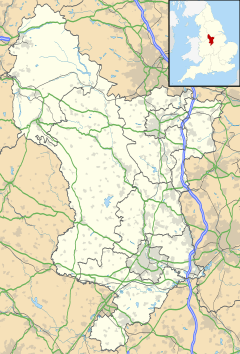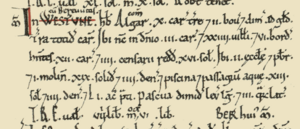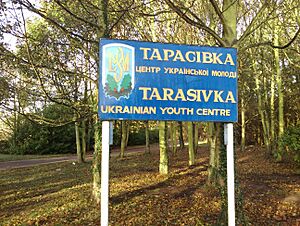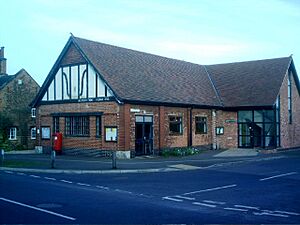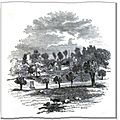Weston-on-Trent facts for kids
Quick facts for kids Weston-on-Trent |
|
|---|---|
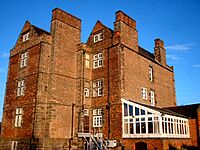 Weston Hall was built by Antony Roper |
|
| Population | 1,239 (2011 census) |
| OS grid reference | SK404280 |
| Civil parish |
|
| District |
|
| Shire county | |
| Region | |
| Country | England |
| Sovereign state | United Kingdom |
| Post town | Derby |
| Postcode district | DE72 |
| Dialling code | 01332 |
| Police | Derbyshire |
| Fire | Derbyshire |
| Ambulance | East Midlands |
| EU Parliament | East Midlands |
| UK Parliament |
|
Weston-on-Trent is a village in Derbyshire, England. In 2011, about 1,239 people lived there. It's located north of the River Trent and the Trent and Mersey Canal. Nearby places include Aston-on-Trent and Castle Donington.
Contents
What's in a Name?
The name "Weston" comes from old English words. It means 'West Town'. This makes sense because Aston-on-Trent ('East Town') is to its east. 'On-Trent' simply means it's near the River Trent.
Weston's Long History
Early History and the Domesday Book
| Domesday Book: In the Domesday Book (1086), Weston was called Westune or Westone. It was one of the few places owned directly by William the Conqueror, the king.
The book said:
|
| – Note: Other areas like Aston-on-Trent and Shardlow were part of Weston's land at that time. |
In 1009, King Ethelred the Unready signed a special paper about Weston. This paper showed Weston's important location and its borders. Weston controlled river crossings at Weston Cliff, King's Mills, and Wilne. These crossings were key routes for people traveling through England.
The land was given to Morcar, a chief minister to the King. He was given special rights, like being in charge of justice. He could even decide if someone lived or died, which was usually only the King's power. Later, Weston came back under the King's control. After the Norman Conquest, it was given to Hugh d'Avranches, 1st Earl of Chester, who then gave it to Chester Abbey.
In 1215, King John of England signed another paper about Weston. He confirmed that the people of Weston were free from certain duties to the county. This was the same year as the Magna Carta, a famous document that limited the King's power.
By 1418, the monks who managed Weston were low on money. So, they rented out the parish of Weston, which still included places like Aston and Shardlow, to the Bishop of Durham.
Weston in the 1600s and 1700s
In 1603, King James I of England gave Weston-on-Trent to Charles Paget. This was surprising because Paget had been involved in the Babington plot, a plan against the previous queen, Mary, Queen of Scots.
In 1633, James I gave the land to Antony Roper. It's believed that this is when Weston Hall, shown in the infobox, started to be built.
During the English Civil War (which started in 1642), soldiers based at Weston Hall attacked Royalist soldiers. Some soldiers were buried in Weston Churchyard after a battle in 1644.
The Roper family sold Weston Hall in 1649, and it was never fully finished. You can still see doorways that were meant to lead to other parts of the building.
In 1745, a Scottish prince, Charles Edward Stuart (also known as Bonnie Prince Charlie), came close to Weston. Local records show that money was spent to fix a town musket (a type of gun) and to buy ale for people watching for the rebels from the church tower.
In September 1770, the Trent and Mersey Canal, designed by James Brindley, reached Weston. This allowed goods to be moved easily between the canal and the river. Many of these old canal structures, like the lock and bridges, are still standing today.
The Railway Arrives in the 1800s
Less than a hundred years later, Weston changed again. Houses were taken down, and roads were moved to make way for the railway, which opened in 1873. The railway "cut through the heart of the village," separating the north and south sides.
The railway company decided to build a new line through Weston. Villagers tried to stop it, but the route was approved. The building work took four years, and the railway was fully open by 1873.
The railway greatly changed village life. The population dropped, and some houses disappeared. The railway cutting divided the village, and new bridges were built. New houses were built for railway workers. Sparks from the trains even set some thatched cottages on fire. By 1871, fewer than half the people still worked on the land. Trains carried milk, mail, and other goods, making Weston a local center for trade.
The railway also reduced traffic on rivers and canals. However, at Weston, the old mill at King's Mill was still important. Gypsum stone from nearby quarries was moved by a special tramway to the canal. From there, it went by canal barge to Weston Cliff, then by river barge to King's Mill. The stone was ground into plaster and sent back the same way. This shows how much effort went into moving goods before modern transport.
Weston in the 1900s and 2000s
The writer H. D. Everett (1851–1923) lived and died in the Old Vicarage in Weston.
In 1937, a big change happened: piped water arrived in the village. This meant houses could have hot and cold water, and a public sewer could be built.
Weston used to have two ferries that crossed the river. One at Weston Cliff and another at King's Mill, which stopped running in 1942. After World War II, Weston-on-Trent became home to the Ukrainian Youth Association (CYM) in the UK. They used one of the camps that had been set up during the war. Famous performers like Vera Lynn and Glenn Miller had even played concerts at these camps.
The last shop in Weston closed in 1998. In 2009, The Old Plough pub closed and was later taken down. This pub had been open for over 175 years.
Weston's School
Weston has one school, a Church of England primary school. The school has been around since 1821. Its old building was used from 1830. In January 2007, the school moved to a new building on the old playing field. It officially opened on April 21st.
Community Groups
Weston has several community groups, including:
- Girls' Brigade
- The 'Scarecrow Trail' (an annual event)
- Guides, Brownies and Rainbows
- Big Easter Scramble (an annual event)
All these groups use the Village Hall as their base.
Walking in Weston
Weston is a good place for walkers, as it's just outside the city of Derby. The parish council looks after several walking routes, and maps are shown at the village hall. Some routes can also be found online.
Weston's Timeline
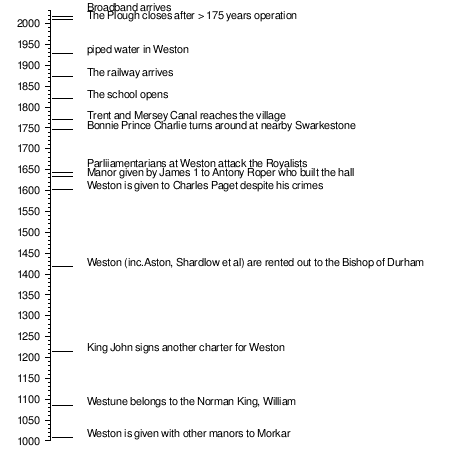
Images for kids
See also
 In Spanish: Weston-on-Trent para niños
In Spanish: Weston-on-Trent para niños


